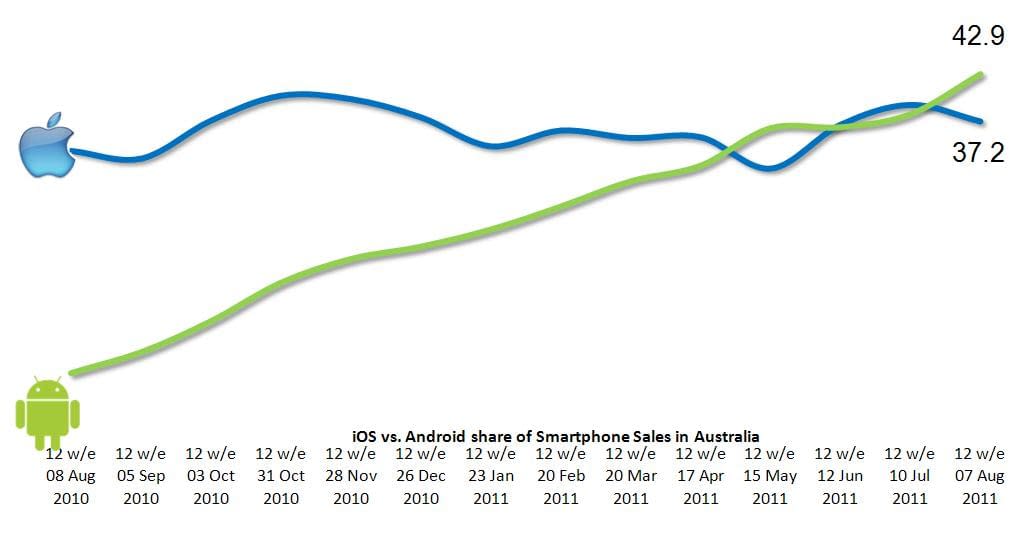
Australia’s smartphone revolution
Australia went from lagging to leading the worldwide smartphone revolution in just one year, a major study by Google has revealed. But about four out of five Australian websites are not optimized for smartphones.
Mobile internet usage by Australians now rivals that of PCs for activities like social networking and, soon, shopping, Google found
Behind Singapore, Australia has the highest smartphone penetration in the world at 37 per cent and we’re also consuming more apps, the research revealed. Australians have on average 25 apps on their phone (eight of which are paid), versus 23 for the US and Britain.
“Australians are increasingly buying stuff via their mobiles with almost a quarter of us having done so … but about four out of five Australian websites are not optimised for smartphones.”
Australians are increasingly buying stuff via their mobiles with almost a quarter of us having done so in the past. Even with the lack of mobile support from Australian businesses, PayPal Australia reports that throughout 2010 mobile transactions increased by 25 per cent every month.
“The rise of smartphones is dramatically increasing the use of the internet overall in Australia and … we’re seeing mobile usage and smartphone usage starting to approach or even match PC usage,” said Ryan Hayward, Google’s mobile product marketing manager for the Asia-Pacific region.
Australians are 33 per cent more likely than those in the US and Britain to do mobile real estate searches and we’re also leading the way in mobile banking, with Australians 65 per cent more likely than the British and 14 per cent more likely than Americans to conduct banking on our phones.
Hayward believes mobile internet usage could soon eclipse PC internet usage as 36 per cent of respondents said they expected to use the web more on the smartphone in the future compared to 28 per cent for the PC.
“We found that with Google Maps, which is one of our marquee products, usage on the mobile phone has already exceeded the desktop globally,” he said.
“The smartphone is not a toy, it’s extremely fundamental and Google is adjusting to it very quickly.”
Hayward said social networking was one category where the gap between mobile and PC usage had closed the most. Sharing of photos and other updates using our phones is now virtually equal to the level of sharing we do from our PCs.
Searches are one of the most popular uses of the mobile internet. Two in five Australians search on their smartphones daily as opposed to three in five on their PC.
Australians are also using their smartphones to find local businesses and a third of Australian smartphone users have made a web-based purchased after conducting a local search.
PayPal Australia said its own experience also showed that Australians were increasingly buying things using their smartphones. Throughout 2010 mobile transactions for PayPal in Australia increased by 25 per cent month on month.
“More than 10 per cent of PayPal Australia’s four million active account holders have transacted on mobile,” said PayPal spokesman Adrian Christie.
“In the last six months over 2000 Australian online merchants have accepted their first mobile payment with PayPal.”
Recent figures from Nielsen put the total volume for the Australian mobile payments market for 2010 at $155 million.
But Google’s research found that in addition to buying things with our phones we’re also using them to compare prices of products before buying and one in five of us have changed our mind about buying something while inside the store.
The rise of smartphones in Australia is a relatively new phenomenon. The research found that four out of five respondents who had a smartphone said it was their first one and one in three bought their smarpthone in the last six months.
“These numbers show that Australia went from lagging to leading the worldwide smartphone revolution in just one year,” Google said.
The growth in mobile internet use is being driven by the iPhone with Apple the smartphone brand used by 46 per cent of respondents, followed by Nokia (19 per cent), Samsung (nine per cent) and HTC (nine per cent).
Hayward said it made sense for Singapore to have a higher smartphone penetration than Australia but some may consider us the true number one.
“Singapore is quite small, it’s less than 10 million people, it’s a city state, there’s a tonne of expats,” he said.
Hayward described the study as the first of its kind worldwide (“it’s the most countries and the most people with the same questions”), and Google plans to release the full report for free in a month on a website called “our mobile planet”.






